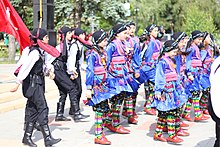

Horon (Pontic: χορόν, romanized: khorón; Laz: oxoronu ) is a group of traditional folk dances from the Eastern Black Sea Region in Turkey.
Name
Etymology
The term horon derives from Greek choros (Greek: χορός, romanized: khorós, see chorus), which means "dance." The earliest instance of its usage in a Turkic language is in Codex Cumanicus from 1303.
In the provinces of Ordu and Giresun, the term horan is used instead of horon.
Variants
Over 50 variations of horon have been identified in a single region.
Origin
Horon or horonu is the Turkish equivalent of the serra war dance of the Pontian Greeks, resembling the ancient Greek Pyrrhic armed dance.
Dance
The horon is typically performed by a group of men or women in a line or semicircle. This dance form involves fast shoulder shimmy (Greek: Τρέμουλο, tremoulo), trembling of the entire body, and sudden squats. Horon dances require speed and agility in a dancer.
See also
- Associated category
- Similar dances
- Dabke, Levantine folk dance
- Khigga, Assyrian folk dance
- Tamzara, folk dance from the Armenian Highlands
References
- Nişanyan, Sevan. "horon". NişanyanSözlük. Retrieved 7 November 2022.
- Gazimihal, Mahmut R. (1991). Türk halk oyunları kataloğu (in Turkish). Kültür Bakanlığı. p. 152. ISBN 978-975-17-0920-2. Retrieved 7 November 2022.
- ^ "Horon Folk Dance". All about Turkey. Retrieved 2023-09-22.
- "The Serra (Horon)". PontosWorld. 22 February 2017. Retrieved 12 February 2024.
- "Top 9 Turkish Culture, Customs and Etiquette". toplist.info. Retrieved 2023-09-22.